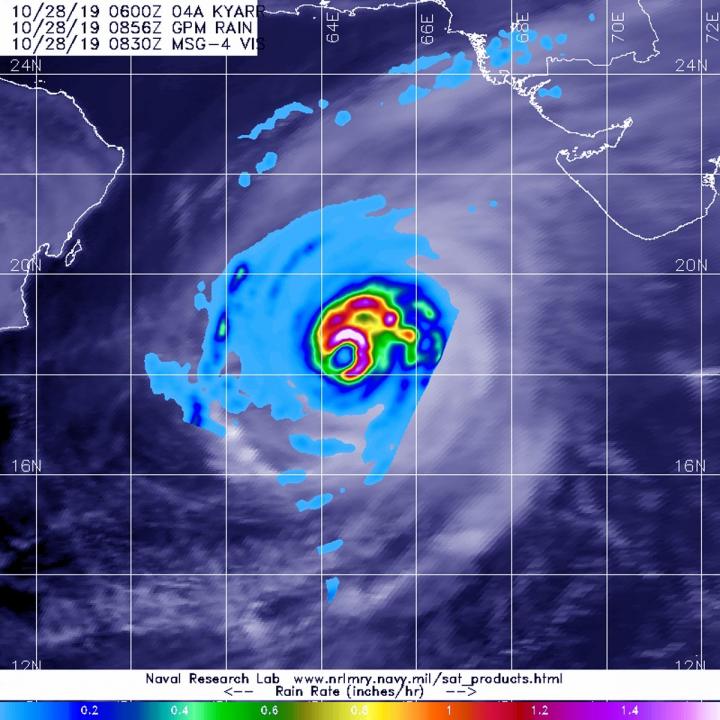
Credit: Credit: NASA/JAXA/NRL
Tropical Cyclone Kyarr is moving through the central Arabian Sea and NASA provided forecasters with an analysis of rainfall rates occurring in the powerful tropical cyclone.
NASA has the unique capability of peering under the clouds in storms and measuring the rate in which rain is falling. Global Precipitation Measurement mission or GPM core passed over Kyarr from its orbit in space and measured rainfall rates throughout the storm.
The GPM’s core satellite passed over Tropical Cyclone Kyarr in the Arabian Sea, Northern Indian Ocean on Oct. 28 at 4:56 a.m. EDT (0856 UTC). GPM found the heaviest rainfall stretching from the northern to the eastern side of the storm where it was falling at a rate of over 40 mm (about 1.6 inches) per hour. Forecasters incorporate the rainfall data into their forecasts.
At 11 a.m. EDT (1500 UTC) on Oct. 28, the Joint Typhoon Warning Center or JTWC noted that Kyarr was located near 18.5 degrees north latitude and 64.4 degrees east longitude, about 337 miles east-southeast of Masirah Island, Oman. Kyarr was moving to the west-northwest and had maximum sustained winds 130 knots (150 mph/241 kph). That means that Kyarr is a major hurricane on the Saffir-Simpson Hurricane Wind scale and is equivalent to a Category 4 hurricane.
Kyarr is moving west and is forecast to start weakening within 24 hours. The storm is then forecast to turn to the west-southwest while slowly weakening as it approaches the Gulf of Aden.
The previous day, on Oct. 27, 2019 at 5:05 p.m. EDT (2105 UTC), the AIRS instrument aboard NASA’s Aqua satellite provided cloud top temperatures using infrared data. Coldest temperatures, as cold as or colder than minus 63 degrees Fahrenheit (minus 53 degrees Celsius) appeared around the eye. NASA research has shown that storms with cloud top temperatures that cold can produce heavy rain, and that heavy rain was seen in the GPM image taken on Oct. 28. The image was created at NASA’s Jet Propulsion Laboratory in Pasadena, California.
Hurricanes are the most powerful weather event on Earth. NASA’s expertise in space and scientific exploration contributes to essential services provided to the American people by other federal agencies, such as hurricane weather forecasting.
###
Both the Japan Aerospace Exploration Agency, JAXA and NASA manage GPM.
Rob Gutro
NASA’s Goddard Space Flight Center, Greenbelt, Md.
Media Contact
Rob Gutro
[email protected]
Original Source
https:/




